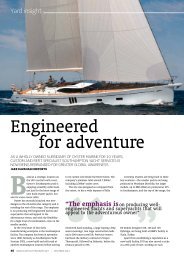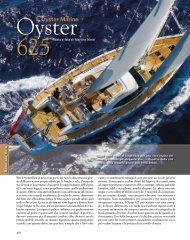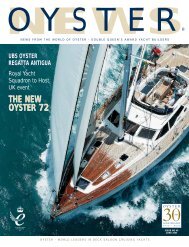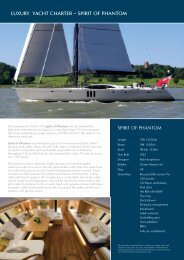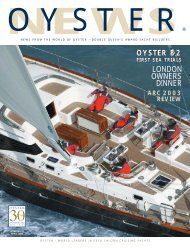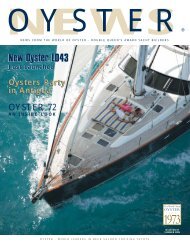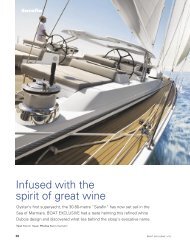Download PDF - Oyster News 66 - Oyster Yachts
Download PDF - Oyster News 66 - Oyster Yachts
Download PDF - Oyster News 66 - Oyster Yachts
You also want an ePaper? Increase the reach of your titles
YUMPU automatically turns print PDFs into web optimized ePapers that Google loves.
OWNER PROFILE<br />
“I respected the sea, but was<br />
confident I could be safe and<br />
function on and under the<br />
sea. I never once had any<br />
fear of sailing.<br />
”<br />
58 www.oystermarine.com<br />
TOP: Arbella during the <strong>Oyster</strong> BVI Regatta 2008<br />
MIDDLE: Mike aged 25 aboard U.S.S. Thomas Jefferson<br />
(SSBN 618), polaris missile submarine, 1972<br />
BOTTOM: Mike and Vicki Wallace onboard Arbella during<br />
passage from Bahamas to Annapolis, 2004<br />
Mike Wallace is Optimistic continued<br />
After graduation in 1969, he spent<br />
six months in a classroom at Mare Island,<br />
California, and six months ‘sailing’ a<br />
land-based, fully-functional Nautilus-type<br />
submarine powered by a nuclear<br />
reactor. His first floating assignment<br />
was the Thomas Jefferson, a ballistic<br />
missile submarine.<br />
His executive officer was Zack Pate,<br />
founder and chairman emeritus of the<br />
World Association of Nuclear Operators.<br />
Pate honed his life-long dedication to<br />
nuclear safety working as assistant to<br />
Admiral Hyman Rickover, the father of the<br />
nuclear Navy.<br />
Pate says he knew very quickly the new<br />
junior officer aboard Thomas Jefferson was<br />
a cut above the rest. "Mike was always<br />
thoughtful about what he was doing,"<br />
Pate says. "And very good with people,<br />
fair-minded. He was always thinking<br />
beyond where most people think. He was<br />
an inquisitive, open-minded person and<br />
had the respect of those who worked<br />
for him."<br />
When he left the Navy in 1974, Wallace<br />
joined Commonwealth Edison in Chicago,<br />
setting his sights on the highest-flying<br />
nuclear project in the private sector that<br />
had government funding: the "breeder"<br />
reactor at Oak Ridge, Tennessee. Breeder<br />
reactors generate new fissionable<br />
material faster than they consume it.<br />
The breeder technology was impressive –<br />
it still is – but Oak Ridge turned out to<br />
be a political football. With cost overruns<br />
over the roof, and President Jimmy Carter<br />
concerned about the plutonium produced<br />
by the reactor leading to accusations of<br />
nuclear weapons proliferation, the Oak<br />
Ridge project was finally cancelled in<br />
1982. But the two-and-a-half years he<br />
spent working at Oak Ridge were<br />
educational for Mike Wallace, both<br />
technically and politically.<br />
He returned to Chicago, working at<br />
ComEd during the day, and attending<br />
University of Chicago at night for his MBA<br />
(in finance). The day job involved two<br />
nuclear plant construction projects in<br />
Illinois: Byron in Rockford, and Braidwood<br />
in Joliet. That’s where Jim Walkington first<br />
met Mike Wallace. Walkington is currently<br />
Senior Vice President (Finance and<br />
Administration) for Constellation Energy’s<br />
Nuclear Group. In 1975, he was<br />
crunching numbers for the construction<br />
of Byron and Braidwood.<br />
"Mike’s the reason I’m here in Baltimore,"<br />
Walkington says. "He’s quite the visionary.<br />
He’s always been in the forefront of the<br />
US nuclear power initiative. Others have<br />
jumped in, but he was the one who saw<br />
the need on the horizon in 1975 when<br />
we were building plants. The energy<br />
business is run by engineers and financial<br />
people. Leadership tends to be left brain,<br />
technically oriented. His innovative<br />
management style sets him apart."<br />
Mike had ideas he wanted to try. He was<br />
casting about for a more exciting job<br />
when ComEd asked him to manage one<br />
of its fossil (coal) fuel plants that needed<br />
a turnaround. Wallace thought that would<br />
look good on his resume, so he agreed.<br />
Then he realized he had no idea how a<br />
fossil plant works. "I’d never even been in<br />
a plant," he says. "I always wondered how<br />
the coal transmitted its heat energy into<br />
the water that would run the turbine.<br />
I had no text book or real experience.<br />
I had to call a friend and ask him what<br />
I should wear!"<br />
Wallace’s first day of work at the fossil<br />
plant is an example of what Zack Pate is<br />
talking about. Wallace is disarmingly<br />
forthright, whether or not the facts are in<br />
his favour. One learns that what you see is<br />
what you get from him. "The various<br />
department heads gathered in my office<br />
for their daily orders," Wallace recalls.<br />
"I said to them, I’m not going to tell you




